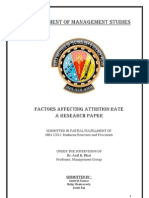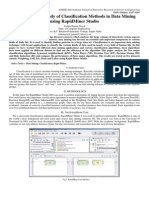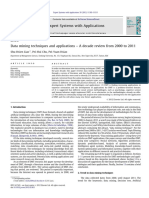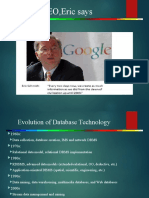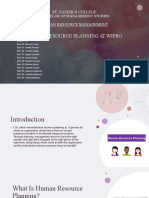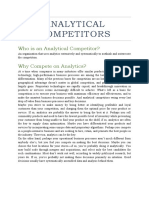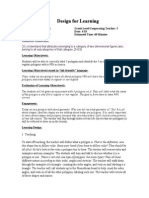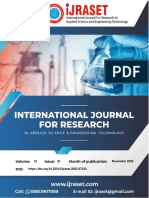Professional Documents
Culture Documents
Human Resource Analytics in Indian Banking Sector
Copyright
Available Formats
Share this document
Did you find this document useful?
Is this content inappropriate?
Report this DocumentCopyright:
Available Formats
Human Resource Analytics in Indian Banking Sector
Copyright:
Available Formats
Volume 5, Issue 5, May – 2020 International Journal of Innovative Science and Research Technology
ISSN No:-2456-2165
Human Resource Analytics in Indian Banking Sector
Prateek Gupta
Student at Department of Human Resource Management
XISS, Ranchi, Jharkhand, India
Abstract:- This study aims to identify and benchmark Descriptive: It includes tradition HR measures which are
the best HR Analytics policies and practices prevailing primarily efficiency metrics like cost of hire, time to fill
in leading banks of India. Also, an external survey was etc. The objective of this is how to reduce cost and
conducted to find out the various Key Performance improve the process. Descriptive analytics sets up a
Indicators (KPI's) for competitive Banks. This research relationship and correlation between the past and current
has used quantitative data types wherein 43 HR data. This provides the foundation of our analytics
executives and managers pitched in their inputs through efforts. It may include dashboards, balanced scorecards,
convenient sampling method. Primary data was reports and data mining.
gathered from the questionnaire which was process
through MS Excel Charts. The results showed that Predictive: Predictive analysis encompasses wide range
almost all banks were having a fierce competition of techniques from statistics, modelling to complex data
amongst themselves when it comes to use of analytics in mining. It uses past and current data and facts to make
HR department. All the major banks are having KPI's predictions about the future. It is based on concept of
around the industry benchmarks as per SHRM. Few probabilities and impact. It constitutes of data models
weakness or area of improvements were also found for which are used to increase the chances of selecting the
certain banks.
right people to recruit, train and promote.
Keywords:- HR Analytics, Banking Sector, People
Prescriptive: Prescriptive analysis is different from
Analytics, Benchmarking.
predictions and focuses on decision alternatives and
I. INTRODUCTION workforce optimization. It analyses complex set of data
to predict forthcoming events, suggest decision
Over the period of last 100 years, Human Resource alternatives and showcase business impacts.
Management function has changed. It has developed from
an transactional function towards the transformational The procedure begins with operational reporting of
function. That is why the term Strategic human resource several HR metrics and goes up to the prescriptive analysis
management is popular now a days. This data driven of business policies. Although financial capital and
methodology behind HR analytics is aligned with the economic capital are important for an organization, it is the
SHRM. When we use the data driven approach, we don’t Human capital which uses financial and economic capital
need to depend upon gut feeling for decision making. Also for organization’s growth (Reddy & Lakshmikeerthi,
analytics helps us to assess that whether the HR policies and 2017).
interventions are effective or not.
As per Baron (2011), People analytics is very much
HR Analytics is viewed as a systematic procedure to content specific and it depends on industry to industry how
understand and identify the relationship amongst the HR much relevant is this to them.
interventions and organization's performance metrics like
Sales or Profit. It also provides meaningful insights for HR HR Analytics aids a company to identify, measure and
decisions which will affect the business strategies and analyze how effective are the HR practices and policies in
performance by use of statistical methods and experimental terms of organizational performance and how they can
methodologies which are based on efficiency and influence the business strategy. It is a very strong tool in
effectiveness metrics (Lawler III, Levenson, & Boudreau, the hands of HR Management so that they can add value to
2004 ; Boudreau & Ramstad, 2006). the organization (Lawler III, Levenson, & Boudreau, 2004).
People analytics is primarily a communications "Benchmarking is defined as the technique of
device. It gathers information from several sources like identifying and adopting industry wide best practices to
surveys and records and then use this to design an action enhance performance.” It is not just a comparative analysis
oriented insight of present scenario and forthcoming events. in which we copy practices from other firms. It constitutes
This is defined as approach which is based on evidence and of learning, spreading information and adopting best
it helps in making better decisions. It is mainly the practices to manage changes in the firm. It can be stated as:
aggregation of primarily objective facts and secondarily 'Improving ourselves by learning from others'.
subjective data. It can be classified in three levels:
IJISRT20MAY513 www.ijisrt.com 422
Volume 5, Issue 5, May – 2020 International Journal of Innovative Science and Research Technology
ISSN No:-2456-2165
In this research, Xerox Benchmarking was From Fig. 1 and Fig. 2, it was observed that majority
incorporated as compared to AT&T’s Benchmarking of the banks were using dashboards for automation of HR
process because of following advantages: If it is done operations. However, few big players are still not using
efficiently, it is a cost effective activity which provide basic dashboards for the operational purpose as well. Few
massive returns; It provides innovation to the firm; it Banks does not even have a dedicated HR Analytics Team
enhances the level of cost awareness and performance to assist them with statistical analysis.
relative to competitors.
II. MATERIAL AND METHODS
In this research, Tool which is used for collecting
primary data was questionnaire. It was developed to collect
the information of both HR Analytics KPI’s and
benchmarking purpose. Tools that were used for secondary
data collections were Bank websites, HR portals and
newspapers from which information about their HR
analytics practices was found and analysed. Apart from Fig 3:- Percentage of banks using different types of
questionnaire, Benchmarking tool was used for this research Dashboards
work.
As observed in Fig. 3, strategic dashboards are used
The respondents of the external survey were HR by least banks. On the contrary it is the most important type
managers and executives of leading private sector banks in of dashboard as it helps the strategy developers.
India. 43 respondents pitched in their inputs related to
several KPI’s related to recruitment. Sampling technique
which was incorporated here was – Convenient Sampling.
Convenient sampling which is also known as grab
sampling is a type of non probability sampling in which
sample is being drawn from that part of population which is
close to the hand.
III. RESULTS
On the basis of external survey that was done through
a questionnaire, following observations were found.
Fig 4:- Different HR Analytics tools used by banks
Today, It is very important for the large companies to
invest in HR analytics tools as they help in keeping a record
of their employee details. Large companies corresponds to
more employees which leads to huge amount of data which
has to be managed. As observed from Fig. 4, Microsoft
Excel is being used by almost all the banks. However, MS
Excel is primarily a spreadsheet tool rather than data
Fig 1:- Percentage of banks having HR Analytics team visualization tool.
Fig 2:- Percentage of banks using HR Dashboards
Fig 5:- Time to fill of different Banks (in Days)
IJISRT20MAY513 www.ijisrt.com 423
Volume 5, Issue 5, May – 2020 International Journal of Innovative Science and Research Technology
ISSN No:-2456-2165
Time to Fill is defined as a measure which
organizations are using to calculate the total number of
days starting from job requisition posting till offer is
accepted. This metric aids in measuring the effectiveness of
recruiting managers within the firm
In Fig. 5, As per the Banking industry standards,
Average time to fill is 32 days and almost all the leading
banks are well within this range.
Fig 8:- Whether banks are measuring satisfaction index or
not
Candidate Satisfaction Survey is a method to evaluate
the candidate’s views of our firm's recruitment process. It
can be done in three approaches. Firstly, survey the
candidates after every selection process. Secondly, survey
only rejected candidates. Lastly, we can survey only the
selected candidates.
Fig 6:- Variation of offer acceptance rate in banks It has been observed from Fig. 8 that majority of the
banks are measuring either of candidate satisfaction, hiring
As per a report from SHRM, ideal offer acceptance
manager satisfaction or both which is very important
rate for any organization should be 90%. The leading banks keeping in mind the strategic decision making.
are having offer acceptance range well within the industry
benchmarks. However, few small and microfinance banks
IV. CONCLUSION
are struggling to reach the industry average as per Fig. 6.
After analyzing the survey output, Strengths and
weaknesses were found for HR analytics in Indian Banks.
Strengths:
No concern for financial issues for supporting HR
Analytics
Time to fill is as per industry average (Nearly 35 days)
Offer acceptance rate is as per industry average (Nearly
90%)
Weaknesses:
Many banks lack dedicated HR analytics team.
Fig 7:- Variation of cost per hire in banks (in Rs.) Adequate usage of dashboard is still not there
Many banks are not measuring hiring manager
Cost per hire is defined as the average amount of satisfaction and candidate satisfaction
money you spent on recruiting a talent. This metric is
No software is used other than MS Excel for analysis
helpful when you are developing your recruiting budget.
and data visualization
Cost per Hire depends on various internal and external
costs incurred by the organization during the recruitment. It
ACKNOWLEDGMENT
also depends upon the type of position; the organization is
trying to fill. As per Fig. 7, All the major banks were
I wish to extend my sincere gratitude to the Acting
exceeding the Industry average of CPH since recruitment
Director of XISS Ranchi, Dr. Amar E. Tigga, Head of
was done mainly through third party agents.
Department Human Resource Management, Dr. Ramakant
Agrawal and Research Guide, Dr. Indrani Ghatak, who
gave me their careful and ardent guidance because of which
I am able to complete this project.
IJISRT20MAY513 www.ijisrt.com 424
Volume 5, Issue 5, May – 2020 International Journal of Innovative Science and Research Technology
ISSN No:-2456-2165
REFERENCES
[1]. Baron, A. (2011). Measuring human capital. Strategic
HR Review, 30-35
[2]. Boudreau, J. W., & Ramstad, P. M. (2006). Talentship
and HR Measurement and Analysis : From ROI to
Strategic Organizational Change. Human Resource
Planning, 25-33.
[3]. Jurevicius, O. (2014, January 19). Benchmarking.
Retrieved from
https://strategicmanagementinsight.com/.
[4]. Lawler III, E. E., Levenson, A., & Boudreau, J. W.
(2004). HR Metrics and Analytics: Use and Impact.
Human Resource Planning, 27-35.
[5]. Mayo, A. (2006). Measuring and reporting – the
fundamental requirement for data. CIPD - Research
Report.
[6]. Momin, W. M., & Mishra, K. (2015). HR Analytics as
a Strategic Workforce Planning. International Journal
of Applied Research, 258-260.
[7]. Reddy, D. R., & Lakshmikeerthi, P. (2017). Hr
Analytics’ - An Effective Evidence Based HRM Tool.
International Journal of Business and Management
Invention, 23-34.
[8]. Thedens, T. (2018 , April 30). HR Analytics: Here is
How to Calculate Your Cost per Hire. Retrieved from
https://www.viasto.com/.
IJISRT20MAY513 www.ijisrt.com 425
You might also like
- CASE STUDY CHAPTER 3 Business EthicsDocument5 pagesCASE STUDY CHAPTER 3 Business EthicsHeidy JosephineNo ratings yet
- Research ProposalDocument14 pagesResearch ProposalNeha Verma100% (1)
- Dissertation Proposal Sample-121eSolutionsDocument11 pagesDissertation Proposal Sample-121eSolutionsMuhammad Arslan UsmanNo ratings yet
- HRIS Needs AnalysisDocument14 pagesHRIS Needs AnalysisMohit Yadav0% (1)
- Leadership in TCS: 1. Motivating Yourself Will Motivate EmployeesDocument5 pagesLeadership in TCS: 1. Motivating Yourself Will Motivate EmployeesPrem GauravNo ratings yet
- Subjective Time. The Philosophy, Psychology, and Neuroscience of Temporality - Arstila, ValtteriDocument687 pagesSubjective Time. The Philosophy, Psychology, and Neuroscience of Temporality - Arstila, ValtteriDanielaMariaD100% (1)
- Research Paperon HRAnalyticsDocument12 pagesResearch Paperon HRAnalyticsMrunalini KhandareNo ratings yet
- Analytics in HR A Recent Transformation in People ManagementDocument4 pagesAnalytics in HR A Recent Transformation in People ManagementInternational Journal of Innovative Science and Research TechnologyNo ratings yet
- The Evolution and Growth of HR Analytics ROI Based ApproachDocument5 pagesThe Evolution and Growth of HR Analytics ROI Based ApproachEditor IJTSRDNo ratings yet
- HR Analytics Methodical Measurement of HR ProcessesDocument4 pagesHR Analytics Methodical Measurement of HR ProcessesInternational Journal of Innovative Science and Research TechnologyNo ratings yet
- Attrition Analysis Payal ModiDocument51 pagesAttrition Analysis Payal ModiNitin ShindeNo ratings yet
- Date & Time: Session Paper No. Authors TitleDocument12 pagesDate & Time: Session Paper No. Authors Titledinabandhu_bagNo ratings yet
- Kushabhau Thakre Patrakarita Avam Jansanchar Vishwavidyalaya Raipur C.GDocument145 pagesKushabhau Thakre Patrakarita Avam Jansanchar Vishwavidyalaya Raipur C.GdeepthiNo ratings yet
- Employee Turnover PredictionDocument9 pagesEmployee Turnover Predictionrohith prabhasNo ratings yet
- Talent Management Strategy of Employee Engagement in Indian ITES Employees: Key To RetentionDocument24 pagesTalent Management Strategy of Employee Engagement in Indian ITES Employees: Key To RetentionShaina MagoNo ratings yet
- Product & Brand Dettol - UnlockedDocument30 pagesProduct & Brand Dettol - UnlockedParakh BansalNo ratings yet
- Data Preparation using RapidMinerDocument87 pagesData Preparation using RapidMinerjessie nando100% (1)
- Strategic Human Resource ManagementDocument1 pageStrategic Human Resource ManagementGauravsNo ratings yet
- Advanced Analytical Text Mining MethodsDocument30 pagesAdvanced Analytical Text Mining Methodsmusadhiq_yavarNo ratings yet
- Employee Future PredictionDocument3 pagesEmployee Future PredictionInternational Journal of Innovative Science and Research TechnologyNo ratings yet
- Research - Attrition RateDocument10 pagesResearch - Attrition RateAnonymous dGnj3bZNo ratings yet
- HRM AssignmentDocument14 pagesHRM AssignmentSteparies Martin100% (15)
- A Comparative Study of Classification Methods in Data Mining Using RapidMiner StudioDocument6 pagesA Comparative Study of Classification Methods in Data Mining Using RapidMiner Studiomishranamit2211100% (1)
- Unit - 5 - HR AnalyticsDocument30 pagesUnit - 5 - HR AnalyticsProf. VIJAY K SNo ratings yet
- Talent ForecastingDocument9 pagesTalent Forecastingabhi_003No ratings yet
- Data Preparation Process PDFDocument30 pagesData Preparation Process PDFIrfan ZubairNo ratings yet
- Employee Attrition Prediction Using KNNDocument3 pagesEmployee Attrition Prediction Using KNNPraveen 23No ratings yet
- Human Resource Accounting in NTPC-3Document4 pagesHuman Resource Accounting in NTPC-3Pashmeen KaurNo ratings yet
- Project ReportDocument80 pagesProject ReportNavneet ChoudharyNo ratings yet
- Mba 3 Sem Business Analytics 18mba302e 2020Document2 pagesMba 3 Sem Business Analytics 18mba302e 2020HoD MBA100% (1)
- HR Analytics PDFDocument8 pagesHR Analytics PDFDr-Shefali Garg100% (1)
- 03 - Literature ReviewDocument7 pages03 - Literature ReviewANJALI JAMESNo ratings yet
- Data Analytics in Human Resource A Case Study and Critical Review PDFDocument9 pagesData Analytics in Human Resource A Case Study and Critical Review PDFVidya Hegde KavitasphurtiNo ratings yet
- Intorduction To Business - AnalyticsDocument40 pagesIntorduction To Business - AnalyticsAbhimanyu ParmarNo ratings yet
- Case Three QuestionsDocument3 pagesCase Three QuestionssaadNo ratings yet
- How Artificial Intelligence (Ai) Is Revolutionizing Learning and Development (L&D) PracticesDocument36 pagesHow Artificial Intelligence (Ai) Is Revolutionizing Learning and Development (L&D) PracticesJhilik Pradhan100% (1)
- A Project Synopsis On: Performance ManagementDocument11 pagesA Project Synopsis On: Performance ManagementMOHAMMED KHAYYUMNo ratings yet
- Application of Business Analytics in HRDocument3 pagesApplication of Business Analytics in HRHalima LariNo ratings yet
- Shivam Gupta 117 RM Lab FileDocument86 pagesShivam Gupta 117 RM Lab FileChelsea SandersNo ratings yet
- Presentation On Tata TeaDocument17 pagesPresentation On Tata TeaMonika RawatNo ratings yet
- Tata Motors (FTSS)Document8 pagesTata Motors (FTSS)Pooja SunkiNo ratings yet
- Analysis DR ReddyDocument10 pagesAnalysis DR ReddyRitik katteNo ratings yet
- 5th Term - Operations ManagementDocument58 pages5th Term - Operations ManagementShreedharNo ratings yet
- Data Mining Techniques and ApplicationsDocument9 pagesData Mining Techniques and Applicationsamandeep651No ratings yet
- HR Policies at Munjal Showa: Areas for ImprovementDocument7 pagesHR Policies at Munjal Showa: Areas for ImprovementGaurav ModiNo ratings yet
- Analysis of Tata's competitive advantage through its resourcesDocument67 pagesAnalysis of Tata's competitive advantage through its resourcesLOVE CHAWLA0% (1)
- Machine Learning: Types of AlgorithmsDocument11 pagesMachine Learning: Types of AlgorithmsHernán Ramírez ZavaletaNo ratings yet
- HRIS-3 Levels Comparison and Competency Framework For HR ProfessionalsDocument14 pagesHRIS-3 Levels Comparison and Competency Framework For HR ProfessionalsmanoharmohantaNo ratings yet
- 2015-BA7301 (1) - Unit 5 (New)Document114 pages2015-BA7301 (1) - Unit 5 (New)Latha Dona VenkatesanNo ratings yet
- Data MiningDocument27 pagesData MiningTestingAccNo ratings yet
- Narayana Murthy's Leadership and Vision Build InfosysDocument0 pagesNarayana Murthy's Leadership and Vision Build InfosysDipesh JainNo ratings yet
- Unit 5: Emerging Trends in HRMDocument27 pagesUnit 5: Emerging Trends in HRManuradhakampli100% (1)
- Nature and Objectives of Management AccountingDocument13 pagesNature and Objectives of Management AccountingpfungwaNo ratings yet
- Case Study Pantaloon RetailDocument8 pagesCase Study Pantaloon RetailShruti AgrawalNo ratings yet
- The Study On Human ResourceDocument33 pagesThe Study On Human ResourceVishwajit Patil100% (1)
- Text AnalyticsDocument21 pagesText AnalyticsBlith RupikaNo ratings yet
- Human Resource Planning at WiproDocument9 pagesHuman Resource Planning at Wiprojayshree agarwalNo ratings yet
- 08 - Key Attributes of Analytical CompetitosDocument4 pages08 - Key Attributes of Analytical CompetitosTusharNo ratings yet
- Influence of AI in HR Skill OptimizingDocument8 pagesInfluence of AI in HR Skill OptimizingInternational Journal of Innovative Science and Research TechnologyNo ratings yet
- Chapter 5 HR Metrics and AnalysticsDocument13 pagesChapter 5 HR Metrics and AnalysticsPhương QuỳnhNo ratings yet
- Unit 1 Introduction To HR AnalyticsDocument20 pagesUnit 1 Introduction To HR AnalyticsGulshan Sharma100% (1)
- Advancing Healthcare Predictions: Harnessing Machine Learning for Accurate Health Index PrognosisDocument8 pagesAdvancing Healthcare Predictions: Harnessing Machine Learning for Accurate Health Index PrognosisInternational Journal of Innovative Science and Research TechnologyNo ratings yet
- Diabetic Retinopathy Stage Detection Using CNN and Inception V3Document9 pagesDiabetic Retinopathy Stage Detection Using CNN and Inception V3International Journal of Innovative Science and Research TechnologyNo ratings yet
- Comparatively Design and Analyze Elevated Rectangular Water Reservoir with and without Bracing for Different Stagging HeightDocument4 pagesComparatively Design and Analyze Elevated Rectangular Water Reservoir with and without Bracing for Different Stagging HeightInternational Journal of Innovative Science and Research TechnologyNo ratings yet
- Design, Development and Evaluation of Methi-Shikakai Herbal ShampooDocument8 pagesDesign, Development and Evaluation of Methi-Shikakai Herbal ShampooInternational Journal of Innovative Science and Research Technology100% (3)
- Terracing as an Old-Style Scheme of Soil Water Preservation in Djingliya-Mandara Mountains- CameroonDocument14 pagesTerracing as an Old-Style Scheme of Soil Water Preservation in Djingliya-Mandara Mountains- CameroonInternational Journal of Innovative Science and Research TechnologyNo ratings yet
- Cyberbullying: Legal and Ethical Implications, Challenges and Opportunities for Policy DevelopmentDocument7 pagesCyberbullying: Legal and Ethical Implications, Challenges and Opportunities for Policy DevelopmentInternational Journal of Innovative Science and Research TechnologyNo ratings yet
- The Impact of Digital Marketing Dimensions on Customer SatisfactionDocument6 pagesThe Impact of Digital Marketing Dimensions on Customer SatisfactionInternational Journal of Innovative Science and Research TechnologyNo ratings yet
- The Utilization of Date Palm (Phoenix dactylifera) Leaf Fiber as a Main Component in Making an Improvised Water FilterDocument11 pagesThe Utilization of Date Palm (Phoenix dactylifera) Leaf Fiber as a Main Component in Making an Improvised Water FilterInternational Journal of Innovative Science and Research TechnologyNo ratings yet
- Dense Wavelength Division Multiplexing (DWDM) in IT Networks: A Leap Beyond Synchronous Digital Hierarchy (SDH)Document2 pagesDense Wavelength Division Multiplexing (DWDM) in IT Networks: A Leap Beyond Synchronous Digital Hierarchy (SDH)International Journal of Innovative Science and Research TechnologyNo ratings yet
- Formulation and Evaluation of Poly Herbal Body ScrubDocument6 pagesFormulation and Evaluation of Poly Herbal Body ScrubInternational Journal of Innovative Science and Research TechnologyNo ratings yet
- Auto Encoder Driven Hybrid Pipelines for Image Deblurring using NAFNETDocument6 pagesAuto Encoder Driven Hybrid Pipelines for Image Deblurring using NAFNETInternational Journal of Innovative Science and Research TechnologyNo ratings yet
- Electro-Optics Properties of Intact Cocoa Beans based on Near Infrared TechnologyDocument7 pagesElectro-Optics Properties of Intact Cocoa Beans based on Near Infrared TechnologyInternational Journal of Innovative Science and Research TechnologyNo ratings yet
- Explorning the Role of Machine Learning in Enhancing Cloud SecurityDocument5 pagesExplorning the Role of Machine Learning in Enhancing Cloud SecurityInternational Journal of Innovative Science and Research TechnologyNo ratings yet
- A Survey of the Plastic Waste used in Paving BlocksDocument4 pagesA Survey of the Plastic Waste used in Paving BlocksInternational Journal of Innovative Science and Research TechnologyNo ratings yet
- A Review: Pink Eye Outbreak in IndiaDocument3 pagesA Review: Pink Eye Outbreak in IndiaInternational Journal of Innovative Science and Research TechnologyNo ratings yet
- Navigating Digitalization: AHP Insights for SMEs' Strategic TransformationDocument11 pagesNavigating Digitalization: AHP Insights for SMEs' Strategic TransformationInternational Journal of Innovative Science and Research TechnologyNo ratings yet
- Automatic Power Factor ControllerDocument4 pagesAutomatic Power Factor ControllerInternational Journal of Innovative Science and Research TechnologyNo ratings yet
- Hepatic Portovenous Gas in a Young MaleDocument2 pagesHepatic Portovenous Gas in a Young MaleInternational Journal of Innovative Science and Research TechnologyNo ratings yet
- Studying the Situation and Proposing Some Basic Solutions to Improve Psychological Harmony Between Managerial Staff and Students of Medical Universities in Hanoi AreaDocument5 pagesStudying the Situation and Proposing Some Basic Solutions to Improve Psychological Harmony Between Managerial Staff and Students of Medical Universities in Hanoi AreaInternational Journal of Innovative Science and Research TechnologyNo ratings yet
- Review of Biomechanics in Footwear Design and Development: An Exploration of Key Concepts and InnovationsDocument5 pagesReview of Biomechanics in Footwear Design and Development: An Exploration of Key Concepts and InnovationsInternational Journal of Innovative Science and Research TechnologyNo ratings yet
- The Effect of Time Variables as Predictors of Senior Secondary School Students' Mathematical Performance Department of Mathematics Education Freetown PolytechnicDocument7 pagesThe Effect of Time Variables as Predictors of Senior Secondary School Students' Mathematical Performance Department of Mathematics Education Freetown PolytechnicInternational Journal of Innovative Science and Research TechnologyNo ratings yet
- Mobile Distractions among Adolescents: Impact on Learning in the Aftermath of COVID-19 in IndiaDocument2 pagesMobile Distractions among Adolescents: Impact on Learning in the Aftermath of COVID-19 in IndiaInternational Journal of Innovative Science and Research TechnologyNo ratings yet
- Enhancing the Strength of Concrete by Using Human Hairs as a FiberDocument3 pagesEnhancing the Strength of Concrete by Using Human Hairs as a FiberInternational Journal of Innovative Science and Research TechnologyNo ratings yet
- Drug Dosage Control System Using Reinforcement LearningDocument8 pagesDrug Dosage Control System Using Reinforcement LearningInternational Journal of Innovative Science and Research TechnologyNo ratings yet
- Securing Document Exchange with Blockchain Technology: A New Paradigm for Information SharingDocument4 pagesSecuring Document Exchange with Blockchain Technology: A New Paradigm for Information SharingInternational Journal of Innovative Science and Research TechnologyNo ratings yet
- Intelligent Engines: Revolutionizing Manufacturing and Supply Chains with AIDocument14 pagesIntelligent Engines: Revolutionizing Manufacturing and Supply Chains with AIInternational Journal of Innovative Science and Research TechnologyNo ratings yet
- Formation of New Technology in Automated Highway System in Peripheral HighwayDocument6 pagesFormation of New Technology in Automated Highway System in Peripheral HighwayInternational Journal of Innovative Science and Research TechnologyNo ratings yet
- Perceived Impact of Active Pedagogy in Medical Students' Learning at the Faculty of Medicine and Pharmacy of CasablancaDocument5 pagesPerceived Impact of Active Pedagogy in Medical Students' Learning at the Faculty of Medicine and Pharmacy of CasablancaInternational Journal of Innovative Science and Research TechnologyNo ratings yet
- Supply Chain 5.0: A Comprehensive Literature Review on Implications, Applications and ChallengesDocument11 pagesSupply Chain 5.0: A Comprehensive Literature Review on Implications, Applications and ChallengesInternational Journal of Innovative Science and Research TechnologyNo ratings yet
- The Making of Self-Disposing Contactless Motion-Activated Trash Bin Using Ultrasonic SensorsDocument7 pagesThe Making of Self-Disposing Contactless Motion-Activated Trash Bin Using Ultrasonic SensorsInternational Journal of Innovative Science and Research TechnologyNo ratings yet
- PMCF LITERACY MaricrisDocument2 pagesPMCF LITERACY MaricrisRoch Shyle Ne100% (1)
- The Different Types of Speech Context and Speech StyleDocument2 pagesThe Different Types of Speech Context and Speech StyleaquelaNo ratings yet
- For Urs DemoDocument37 pagesFor Urs DemoRhine CrbnlNo ratings yet
- ACFrOgDbUDwBpyzaf-WscNRYnhXW02neLVMxDFiMXFlM1zH7egiz3BSqIhWJrwfXNkwl2TGeDj8zC 4mAtHzCj TA1otV1Wix0KiY n30tAJijbqE8g6 El4HTuUjvRIvWZOTf0RqmxUuVUErAmpDocument2 pagesACFrOgDbUDwBpyzaf-WscNRYnhXW02neLVMxDFiMXFlM1zH7egiz3BSqIhWJrwfXNkwl2TGeDj8zC 4mAtHzCj TA1otV1Wix0KiY n30tAJijbqE8g6 El4HTuUjvRIvWZOTf0RqmxUuVUErAmpEunice ArutaNo ratings yet
- Sekolah Menengah Kebangsaan Seksyen 1 Bandar Kinrara 47180 Puchong, Selangor. Annual Scheme of Work 2016Document9 pagesSekolah Menengah Kebangsaan Seksyen 1 Bandar Kinrara 47180 Puchong, Selangor. Annual Scheme of Work 2016Vr_ENNo ratings yet
- Edu 214 - Assignment 1Document2 pagesEdu 214 - Assignment 1api-594749217No ratings yet
- Reflection 2Document5 pagesReflection 2api-265383983No ratings yet
- Pakistani TestsDocument5 pagesPakistani TestsHaleema BuTt100% (1)
- Preparedness of Practice Teaching Internship of Beed Student of Central Philippines State UniverDocument15 pagesPreparedness of Practice Teaching Internship of Beed Student of Central Philippines State UniverRan TanNo ratings yet
- PolygonsDocument3 pagesPolygonsapi-242739728No ratings yet
- American Sign Language Recognition Using Machine Learning and ComDocument57 pagesAmerican Sign Language Recognition Using Machine Learning and ComGurudev YankanchiNo ratings yet
- Varthis Columbia 0054D 13224Document100 pagesVarthis Columbia 0054D 13224MARLON MARTINEZNo ratings yet
- Math Lesson Plan - IntegersDocument11 pagesMath Lesson Plan - IntegersIna Mae SisonNo ratings yet
- Day 1 - Direct Instruction Lesson Plan Food WebsDocument5 pagesDay 1 - Direct Instruction Lesson Plan Food Websapi-328213101No ratings yet
- Baler Central School Kindergarten Guava Accomplishment Report I. Pupils' Development/ AccomplishmentDocument9 pagesBaler Central School Kindergarten Guava Accomplishment Report I. Pupils' Development/ AccomplishmentNINIA MARIE ROQUENo ratings yet
- Demerits of Bruner's Discovery Learning Theory HighlightedDocument8 pagesDemerits of Bruner's Discovery Learning Theory HighlightedShabana AnjumNo ratings yet
- Paper 1: Organization & Management Fundamentals - Syllabus 2008 Evolution of Management ThoughtDocument27 pagesPaper 1: Organization & Management Fundamentals - Syllabus 2008 Evolution of Management ThoughtSoumya BanerjeeNo ratings yet
- Credit Card Fraud Detection Using Machine LearningDocument10 pagesCredit Card Fraud Detection Using Machine LearningIJRASETPublicationsNo ratings yet
- Week 2 EIM 12 Q1 Indoyon Evaluated ESDocument8 pagesWeek 2 EIM 12 Q1 Indoyon Evaluated ESMarino L. SanoyNo ratings yet
- The Case of Big Sarge: Overcoming Depression and Low Self-WorthDocument18 pagesThe Case of Big Sarge: Overcoming Depression and Low Self-WorthDennis HigginsNo ratings yet
- PHYSIOLOGICAL AND PSYCHOLOGICAL BARRIERSDocument5 pagesPHYSIOLOGICAL AND PSYCHOLOGICAL BARRIERSVivek unnikrishnanNo ratings yet
- "CITHM WEEK 2021": ObjectiveDocument2 pages"CITHM WEEK 2021": Objectivema. trisha berganiaNo ratings yet
- Annotated BibliographyDocument5 pagesAnnotated BibliographyBrian MaingiNo ratings yet
- Questionnaire Life Long Learners With 21ST Century Skills PDFDocument3 pagesQuestionnaire Life Long Learners With 21ST Century Skills PDFHenry Buemio0% (1)
- Melissa Smith Website ResumeDocument3 pagesMelissa Smith Website Resumeapi-255350959No ratings yet
- Classroom Management Strategies for Diverse LearnersDocument3 pagesClassroom Management Strategies for Diverse LearnersAngelo SinfuegoNo ratings yet
- Basic of Learner Centered ApproachDocument18 pagesBasic of Learner Centered Approach206 Anchu R.SNo ratings yet
- Uncertainty Environments and Game Theory SolutionsDocument10 pagesUncertainty Environments and Game Theory Solutionsjesica poloNo ratings yet
- Equivalence in Translation TheoryDocument30 pagesEquivalence in Translation TheoryOksana KrychkivskaNo ratings yet




















